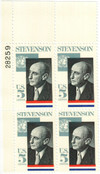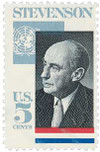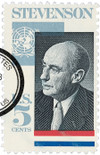
1965 5c Adlai Stevenson
# 1275 - 1965 5c Adlai Stevenson
$0.35 - $18.50
U.S. #1275
5¢ Adlai Stevenson
5¢ Adlai Stevenson
Issue Date: October 23, 1965
City: Bloomington, IL
Quantity: 128,495,000
Printed By: Bureau of Engraving and Printing
Printing Method: Lithographed, engraved
Perforations: 11
Color: Multicolored
City: Bloomington, IL
Quantity: 128,495,000
Printed By: Bureau of Engraving and Printing
Printing Method: Lithographed, engraved
Perforations: 11
Color: Multicolored
Adlai Stevenson II was born on February 5, 1900, in Los Angeles, California.
U.S. #1275
5¢ Adlai Stevenson
5¢ Adlai Stevenson
Issue Date: October 23, 1965
City: Bloomington, IL
Quantity: 128,495,000
Printed By: Bureau of Engraving and Printing
Printing Method: Lithographed, engraved
Perforations: 11
Color: Multicolored
City: Bloomington, IL
Quantity: 128,495,000
Printed By: Bureau of Engraving and Printing
Printing Method: Lithographed, engraved
Perforations: 11
Color: Multicolored
Adlai Stevenson II was born on February 5, 1900, in Los Angeles, California.










